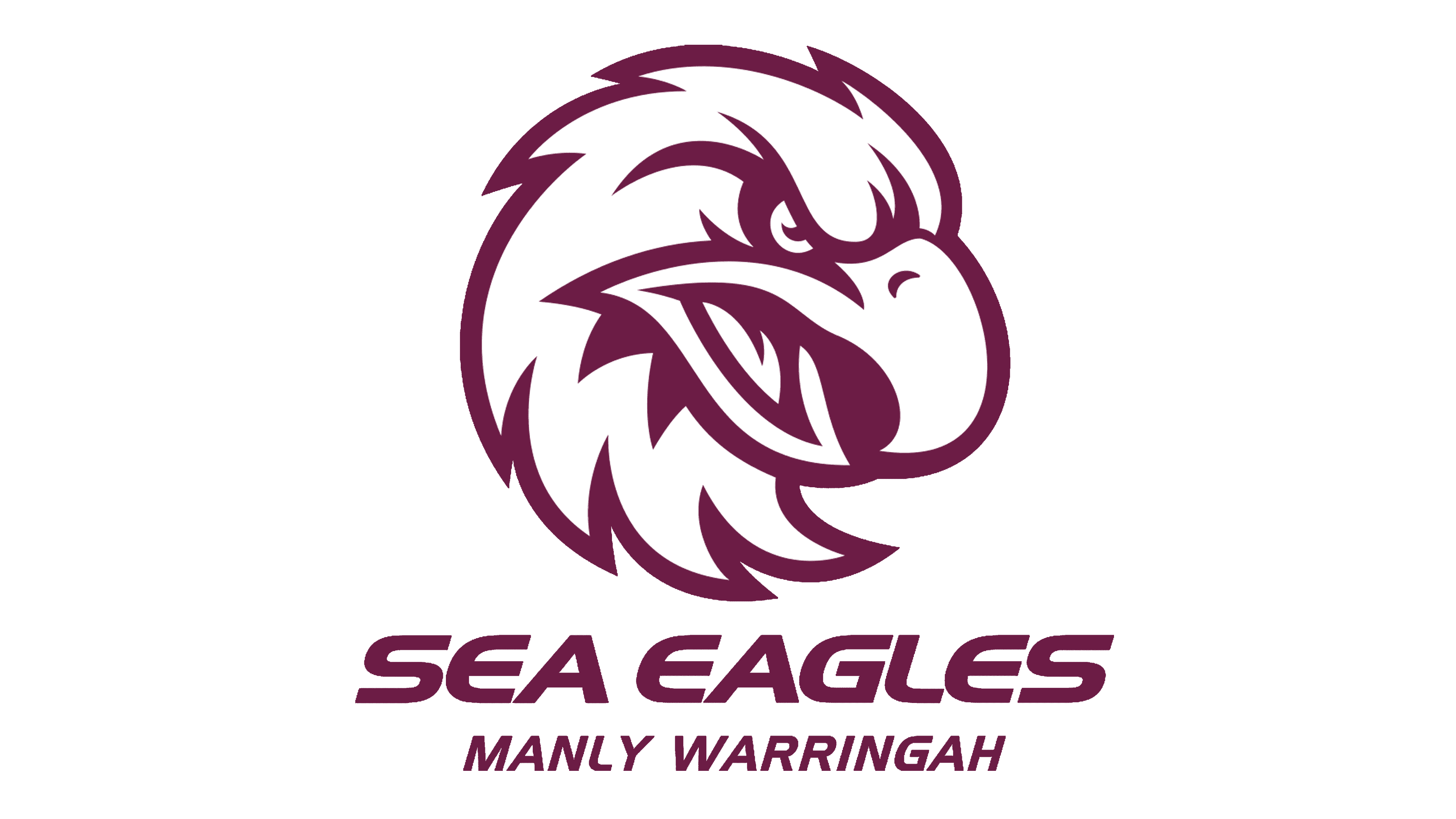Manly Warringah Sea Eagles Logo
This professional rugby league club, based in Sydney, Australia, was founded by a group of rugby enthusiasts in the Northern Beaches region. They established the club with the aim of competing in the national rugby league and representing their local community.
Meaning and history
The Manly Warringah Sea Eagles were founded in 1946. They entered the New South Wales Rugby League (NSWRL) competition in 1947. The club won their first premiership in 1972. Another notable success came in 1973 when they secured back-to-back titles. The Sea Eagles continued to build on their success with premierships in 1976 and 1978. In 1987, the team clinched another premiership, reinforcing their dominance in the league. The 1990s saw further success with titles in 1996. In 2008, the Sea Eagles achieved one of their most significant victories by winning the Grand Final with a record-breaking score. They added another title in 2011, continuing their legacy. The Sea Eagles have produced many famous players and maintained a competitive presence in the NRL, the current national competition. Their history reflects resilience, community support, and a dedication to rugby league excellence.
What is Manly-Warringah Sea Eagles?
The Manly-Warringah Sea Eagles, a renowned Australian rugby league team, host their home games at Brookvale Oval. They are celebrated for their strong competitive spirit and boast a loyal fan base along with a rich history of success in the league.
1947 – 1955
The logo features a shield outline with the letters “M” and “W” prominently displayed inside. The “M” is on the left side, and the “W” is on the right. Both letters are large and bold, colored in a dark red hue. The shield’s border is also red, matching the letters. The design is simple and clean, with a focus on the initials “M” and “W”. The background of the shield is white, providing a stark contrast to the red elements. This combination creates a strong visual impact.
1956
The new logo features an eagle instead of a shield. The eagle, in dark red, stands on a yellow oval background. Its head is white, contrasting with the dark red body. Below the eagle, the letters “MW” are prominently displayed in white on a dark red base. The overall design is more detailed and dynamic than the previous logo. The color scheme remains consistent with the previous red and white theme. The addition of the eagle symbolizes strength and focus, enhancing the visual appeal.
1957 – 1959
The new logo features a white eagle with spread wings inside a dark red circle. The eagle is more stylized and symmetrical than the previous design. The yellow background is replaced with a solid dark red circle. The letters “MW” remain under the eagle, but the base is now white, matching the eagle. The design is cleaner and more modern, emphasizing simplicity and boldness. The color palette is streamlined to dark red and white, enhancing visual clarity and impact.
1960 – 1977
The updated logo presents a more dynamic eagle in flight within the same dark red circle. The eagle’s wings are raised higher, giving it an energetic appearance. The “MW” letters remain, but the base is now an oval, aligning with the eagle’s talons. The design retains the dark red and white color scheme but emphasizes motion and vitality. The eagle’s silhouette is sharper and more detailed, enhancing the overall visual impact. The changes create a sense of movement and strength, further modernizing the logo.
1978 – 1979
The new logo showcases a more detailed and aggressive eagle in mid-flight. The eagle is dark red with white accents, set against a yellow background. It is enclosed in a yellow circle with a dark red border. The words “SEA EAGLES” are at the top, and “MANLY-WARRINGAH” at the bottom, both in dark red. The design is more intricate, with feathers and features clearly defined. The overall look is dynamic and modern, emphasizing strength and motion. The inclusion of text adds clarity and identity to the logo.
1980 – 1997
The new logo features a similar eagle design but with a simplified color scheme. The background is now white, and the outer circle is dark red. The eagle remains dark red with white accents, maintaining its aggressive pose. The text “SEA EAGLES” and “MANLY-WARRINGAH” are still present, now in dark red. The overall design is cleaner and more refined, enhancing readability and visual impact. The reduction in colors simplifies the logo, making it more modern and professional. The changes emphasize clarity and a stronger visual identity.
1998 – 1999
The new logo is significantly more dynamic and colorful. It features a fierce, detailed eagle in flight, with bold, extended wings. The eagle is more cartoon-like, with vibrant red, white, and yellow colors. The background includes a dark red circle with a blue outline. The text “SEA EAGLES” is prominently displayed in large, yellow, 3D letters with red shadows. “MANLY-WARRINGAH” appears above the eagle, arched along the circle. This redesign emphasizes energy, modernity, and a bold, eye-catching appearance, creating a strong and lively visual identity.
2003 – 2023
The new logo retains the fierce eagle but with updated styling and colors. The eagle is now more detailed, with pronounced feathers and sharper lines. The colors are darker, featuring maroon, white, and navy blue. The background circle has a triple-layered ring with maroon and white. The text “MANLY WARRINGAH” appears at the top, and “SEA EAGLES” at the bottom, in bold white letters. The eagle’s expression is more aggressive, emphasizing strength. The overall design is modern, detailed, and visually impactful, enhancing the team’s identity.
2023 – Today
The new logo features a simplified, stylized eagle head in dark maroon. The eagle’s expression is fierce and modern, with bold lines and sharp edges. The background elements are removed, focusing solely on the eagle head. Below the eagle, “SEA EAGLES” is written in large, bold, italicized maroon letters. “MANLY WARRINGAH” appears underneath in smaller, italicized maroon text. The design is minimalist, emphasizing a clean, powerful visual identity. The removal of extraneous details enhances clarity and modernity, creating a strong and impactful logo.

















